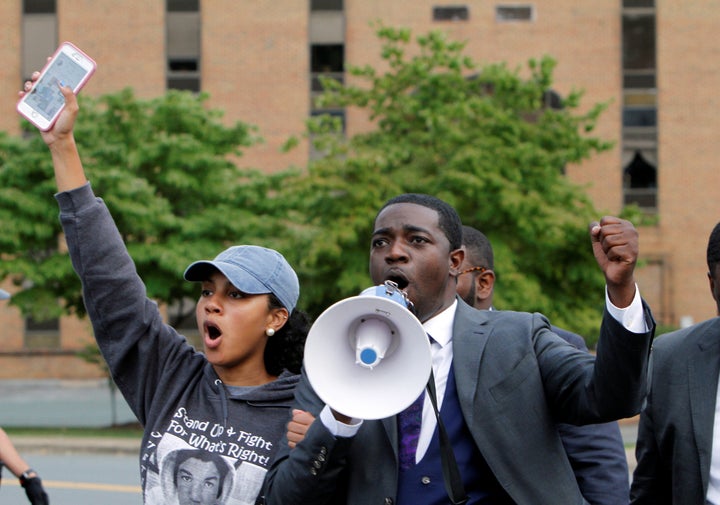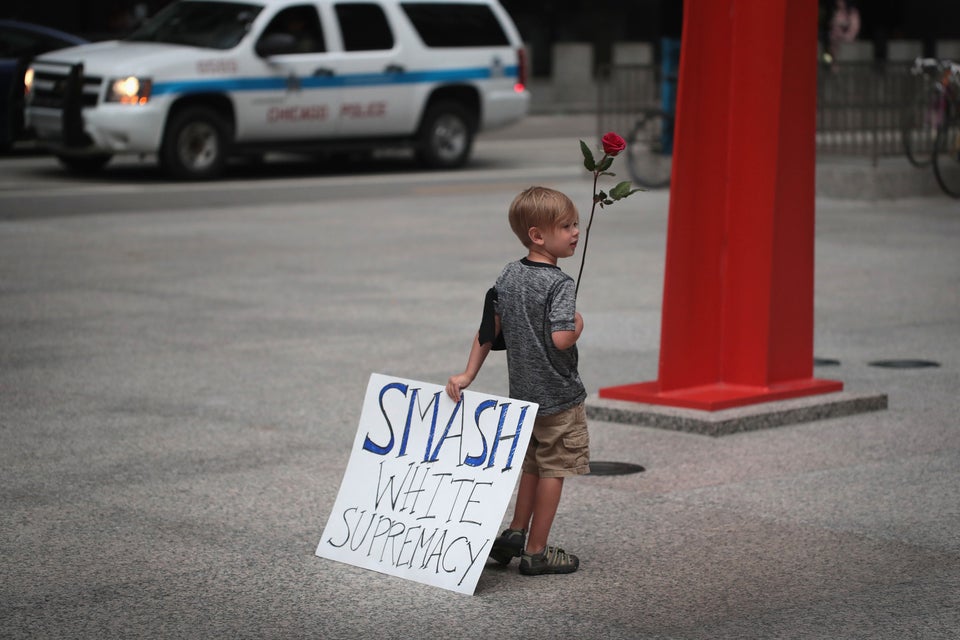Braving the rain, threats of violence and uncertainty over police permits, dozens of civil rights activists set out on the sixth day of their 118-mile trek from Charlottesville, Virginia, to Washington, D.C., on Saturday to protest the white supremacist ideas that inspired deadly violence in Charlottesville a few weeks ago.
The 10-day journey, which organizers from progressive and faith organizations are calling a “March to Confront White Supremacy,” began on Monday with a rally in Charlottesville’s Emancipation Park and is due to conclude this coming Wednesday with nonviolent civil disobedience in the nation’s capital.
With an escort from the Virginia State Police and Virginia Department of Transportation, the rain-gear-clad marchers spent Saturday walking 13 miles along Route 29 from Remington to Warrenton ― all while waving placards with messages like “Black Lives Matter” and singing racial justice-themed songs. Participation in the march varies from one day to the next, but organizers estimated that there were 80 people marching on Saturday.
The marchers are calling for President Donald Trump’s impeachment, the removal of all white supremacists from his administration, and an end to policies that disproportionately impact people of color, including criminal justice and policing practices.
“We’re marching to say enough is enough,” said Puja Datta, a 29-year-old Working Families Party organizer who traveled from Columbus, Ohio, to participate in the march.
“People of color demand true liberation and equality and there’s no reason why we shouldn’t have it,” she continued. “And there’s absolutely no reason why neo-Nazis should be rising again. America already fought them once and beat them back.”

The marchers have already overcome racially-motivated intimidation, the kind of which they have assembled specifically to protest. Wednesday’s leg of the march ended early after organizers received threats that an armed person was awaiting them at their destination in Madison, Virginia.
The trek has nonetheless proceeded without violence ― and picked up high-profile support along the way. Hollywood star and progressive activist Mark Ruffalo joined the marchers on Friday, documenting his journey on social media.
The same day, however, activists suffered a setback when Virginia State Police withdrew approval for them to walk on the road, asking that they stop or continue by car for the remainder of the day’s route, according to police.
The state police cited concerns about the rainy weather and the impact of the march on traffic at the start of Labor Day weekend, which police spokeswoman Corinne Geller told HuffPost had resulted in a 4-mile backup.
The decision cut the fifth day of the march short by 3 miles, and prompted march organizers to accuse the police and Virginia Gov. Terry McAuliffe (D) of foul play.
“Today the Virginia State Police revoked our permit because of non-existent ‘rain and traffic,’ and threatened to arrest us if we marched,” marcher Ben Doernberg said in a Friday statement. “[Virginia] Gov. Terry McAuliffe’s double standard is as clear as the skies and roads, and his disregard for the rights of non-racists is appalling and shameful.”
The police acted in good faith, resuming the escort on Saturday, Geller said in an e-mail message.
The police are “better behaved today,” Datta told Huffpost on Saturday.
Geller emphasized, however, that law enforcement reserves the right to make similar demands of the marchers in the future.
“As this march advances into Northern Virginia, traffic congestion and safe passage for the marchers will become even more of an issue,” she said. “State police and VDOT are in constant communication with the march organizers to discuss what is in their best interest in regards to creating a safe environment that will enable them to achieve their intended goals each day.”
The march, which uses the social media hashtag #Cville2DC, is part of a wave of progressive activism in the wake of the Aug. 12 white supremacist rally in Charlottesville that resulted in the death of anti-racist counterprotester Heather Heyer and injuries of countless other demonstrators. James Fields, a member of the so-called “alt-right” from Ohio, stands accused of killing Heyer and injuring others by ramming his car into a crowd. He now faces charges of 2nd-degree murder and other offenses.
Many Americans were appalled by the white supremacist rally, Heyer’s death and Trump’s subsequent attempts to draw equivalencies between the neo-Nazi protesters and anti-racist counterprotesters who assembled peacefully. Civil rights advocates vastly outnumbered white supremacist demonstrators at a counter-rally in Boston, Massachusetts, and enveloped similar protesters in San Francisco and Berkeley, California.
The groups behind this march include the Working Families Party, the Women’s March, Color of Change, Democracy Spring, the Movement for Black Lives, the Center for Popular Democracy, the International Union of Painters and Allied Trades, Pico National Network, United We Dream, ResistHere, the March for Racial Justice, Million Hoodies Movement for Justice and IfNotNow.
Hurricane Harvey and the destruction it has wrought on southeastern Texas and Louisiana have cast something of a shadow over the March to Confront White Supremacy as media outlets and progressive allies focus on responding to the disaster.
But marcher Nelini Stamp, the New York-based membership director of the Working Families Party, called the devastating storm another case study of how white supremacy affects policy outcomes, arguing in a Facebook Live video on Thursday that the government’s preparation and response to the disaster had failed Houston’s communities of color. She encouraged viewers to visit NoRedCross.org to find local aid organizations to contribute to. (The Red Cross has incurred liberal skepticism for what critics describe as a shoddy, publicity-seeking disaster response apparatus.)
“What’s happening in Houston is exactly white supremacy ― the fact that President Donald Trump did not acknowledge it until much later on and he didn’t go visit any victims of the flood, the fact that he … has been defunding programs that protect black and brown communities during natural disasters,” she said. “We stand in solidarity with Houston. We’re sending love.”

